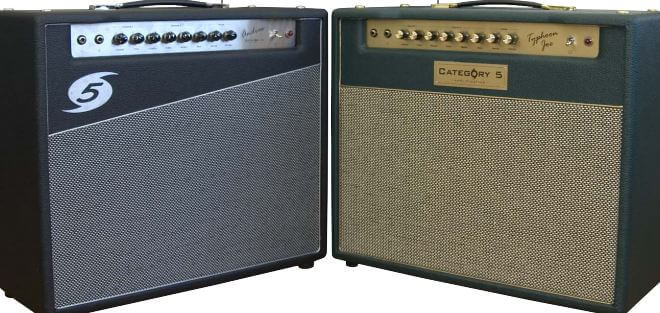
CATEGORY 5’S ANDREWAND Typhoon Joe are all-tube, handwired two-channel amps with top-of-the-line Mercury Magnetics transformers, JJ and Tech-Cap electronics, Analysis Plus speaker wire, and silver-tinned Teflon wire, all attached to a two-millimeter aluminum chassis in an 11-ply Baltic birch cabinet fitted with Jensen Neo speakers.
Both amps have multiple-impedance capability, two speaker jacks, a line-out, and an adjustable line level.
There are controls for two non switchable channels on the front panel, with Volume and Tone controls for the first, and Volume, Treble, Middle, Bass for the second. A section labeled Global affects both channels, with a single control for reverb.
Using a reissue Gibson Les Paul Special with P-90 pickups and a kit guitar with Rio Grande single-coils, the 45-watt Typhoon Joe (with four 12AX7s, two EL34s and a solid state rectifier) sounds great and is a snap to control in terms of volume. Adjusting its overall output via the Wattage control lets the amp maintain its tonal characteristics no matter how many picture frames fall from the walls! There is a slight increase in headroom as voltage is dialed up, and a softening of the edges on the distortion as the voltage goes down, but it’s very subtle. And the EQ is remarkably consistent – a relief for those who’ve played amps that require channel-volume adjustment and tone-knob tweaks if they touch the Master. An A/B comparison confirmed the characteristic was common to both amps.
With its dual EL34s and 100-watt/12” speaker, the Typhoon Joe pushed out gorgeous tones with a distinctly British voice. Channel one gives a straight-up Marshall JTM45-like tone with single-coil pickups that help it produce a combination of mid range throatiness with high-end chime. The Typhoon is relatively clean (for a Marshall-type amp) to just past half-way on the Volume dial. Keep it below that, though, and it’s oh-so-easy to get Robert Cray-style cluck. Channel 2 has a late-’65s Marshall plexi tone at lower volumes, but the distortion become screamier as the Volume knob is dialed up. Even at upper settings, there wasn’t a hint of harshness, just more sustain.The P-90s had Channel 1 singing with the Volume knob halfway up. Using the bridge pickup with the Volume at three-quarters brought out a tight, rich, distortion, while turning down the Tone smoothed out the edge without killing the highs. The neck pickup was warm,even when driven hard, but did not become muddy, revealing the sound Larry McCray described in a recent interview as “woofy.” The P-90s were pure velvet in Channel 2 from about 40percent on up – rich, with just a bit of edge to keep the notes distinct.
Although the Andrew is rated at a few watts less than the Typhoon Joe, its two 100-watt 10” speakers make it seem louder. Its two 5881 tubes give it a more American sound and, if that’s not to your liking, a bias circuit allows the Andrew to run a variety of octal power tubes, including 6V6, 6L6,EL34, KT66, and even KT77 tubes,without re-biasing. Channel one has a pre-blackface Deluxe tone, if only the Deluxe weighed about 400 pounds.Clean(er) Fender tones prevail up to about halfway on the Volume, and after that it has slightly scooped mids with hair. The bridge-pickup tone was remarkably smooth, with no brittle highs. Channel 2 continued the Fender tones and sounded like a Super, but a little cleaner, like it had mated with a Twin. While the neck pickup was glassy, the middle pickup was called into service more than usual, Channel 2 bringing out the usual warmth of a middle Strat pickup, but with more clarity and aggression.
If you like P-90s, plugging into the Andrew is going to have a serious impact on the amount of sleep you get and how often you get out of the house.The neck pickup had a slight glass-on-steel sound like any good Strat pickup, but the Andrew emphasizes it while bolstering the added mids of a P-90. With the Volume at about 60 percent, the slightly under wound neck pickup was warm, full, and just a little edgy. Combining both pickups with the three-way switch in the middle gave a B.B.-type tone, only a little darker and more menacing. The bridge pickup by itself had more snarl and bite than with the Typhoon Joe.
Though neither Category 5 amp offers channel switching, their channels are in phase, so an A/B/Y footswitch allows for days of tonal exploration. And because of the Wattage control, both amps make great bedroom and studio amps that produce full-bodied distortion at low volumes. – Bob Dragich